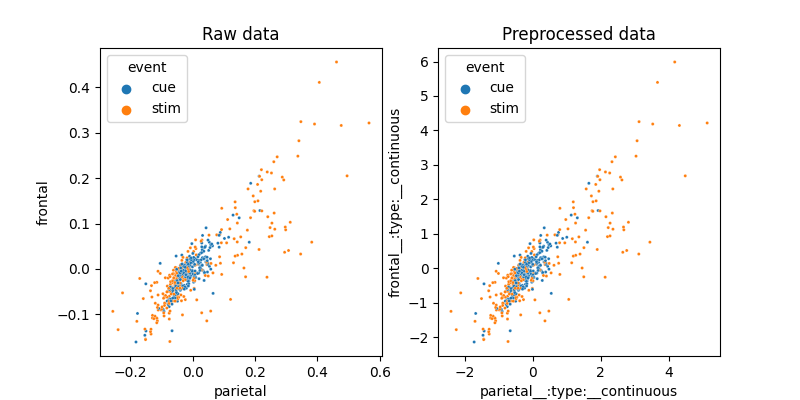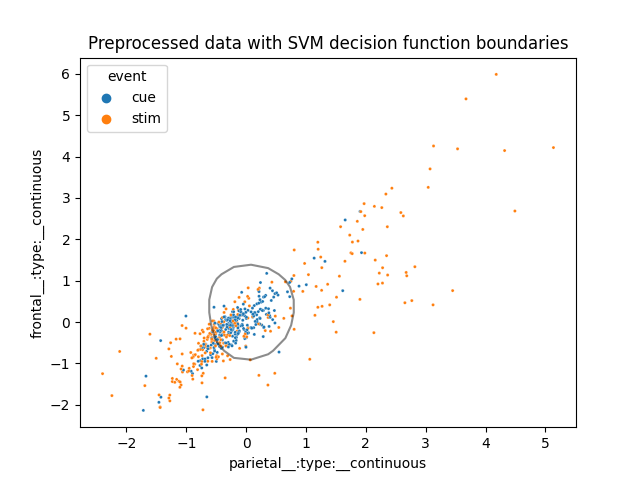Note
Go to the end to download the full example code
Inspecting SVM models#
This example uses the fmri dataset, performs simple binary classification
using a Support Vector Machine classifier and analyse the model.
References#
Waskom, M.L., Frank, M.C., Wagner, A.D. (2016). Adaptive engagement of cognitive control in context-dependent decision-making. Cerebral Cortex.
# Authors: Federico Raimondo <f.raimondo@fz-juelich.de>
# Shammi More <s.more@fz-juelich.de>
# License: AGPL
import numpy as np
import pandas as pd
from sklearn.model_selection import GroupShuffleSplit
import matplotlib.pyplot as plt
import seaborn as sns
from seaborn import load_dataset
from julearn import run_cross_validation
from julearn.utils import configure_logging
from julearn.inspect import preprocess
Set the logging level to info to see extra information.
configure_logging(level="INFO")
/home/runner/work/julearn/julearn/julearn/utils/logging.py:66: UserWarning: The '__version__' attribute is deprecated and will be removed in MarkupSafe 3.1. Use feature detection, or `importlib.metadata.version("markupsafe")`, instead.
vstring = str(getattr(module, "__version__", None))
2025-07-07 11:53:02,965 - julearn - INFO - ===== Lib Versions =====
2025-07-07 11:53:02,965 - julearn - INFO - numpy: 1.26.4
2025-07-07 11:53:02,965 - julearn - INFO - scipy: 1.15.3
2025-07-07 11:53:02,965 - julearn - INFO - sklearn: 1.5.2
2025-07-07 11:53:02,965 - julearn - INFO - pandas: 2.2.3
2025-07-07 11:53:02,965 - julearn - INFO - julearn: 0.3.5.dev28
2025-07-07 11:53:02,965 - julearn - INFO - ========================
Dealing with Cross-Validation techniques#
df_fmri = load_dataset("fmri")
First, let’s get some information on what the dataset has:
print(df_fmri.head())
subject timepoint event region signal
0 s13 18 stim parietal -0.017552
1 s5 14 stim parietal -0.080883
2 s12 18 stim parietal -0.081033
3 s11 18 stim parietal -0.046134
4 s10 18 stim parietal -0.037970
From this information, we can infer that it is an fMRI study in which there were several subjects, timepoints, events and signal extracted from several brain regions.
Let’s check how many kinds of each we have.
['stim' 'cue']
['parietal' 'frontal']
[0, 1, 2, 3, 4, 5, 6, 7, 8, 9, 10, 11, 12, 13, 14, 15, 16, 17, 18]
['s13' 's5' 's12' 's11' 's10' 's9' 's8' 's7' 's6' 's4' 's3' 's2' 's1' 's0']
We have data from parietal and frontal regions during 2 types of events (cue and stim) during 18 timepoints and for 14 subjects. Let’s see how many samples we have for each condition
print(df_fmri.groupby(["subject", "timepoint", "event", "region"]).count())
print(
np.unique(
df_fmri.groupby(["subject", "timepoint", "event", "region"])
.count()
.values
)
)
signal
subject timepoint event region
s0 0 cue frontal 1
parietal 1
stim frontal 1
parietal 1
1 cue frontal 1
... ...
s9 17 stim parietal 1
18 cue frontal 1
parietal 1
stim frontal 1
parietal 1
[1064 rows x 1 columns]
[1]
We have exactly one value per condition.
Let’s try to build a model, that uses parietal and frontal signal to predicts whether the event was a cue or a stim.
First we define our X and y variables.
In order for this to work, both parietal and frontal must be columns. We need to pivot the table.
The values of region will be the columns. The column signal will be the values. And the columns subject, timepoint and event will be the index
df_fmri = df_fmri.pivot(
index=["subject", "timepoint", "event"], columns="region", values="signal"
)
df_fmri = df_fmri.reset_index()
Here we want to zscore all the features and then train a Support Vector Machine classifier.
2025-07-07 11:53:02,984 - julearn - INFO - ==== Input Data ====
2025-07-07 11:53:02,984 - julearn - INFO - Using dataframe as input
2025-07-07 11:53:02,984 - julearn - INFO - Features: ['parietal', 'frontal']
2025-07-07 11:53:02,984 - julearn - INFO - Target: event
2025-07-07 11:53:02,984 - julearn - INFO - Expanded features: ['parietal', 'frontal']
2025-07-07 11:53:02,984 - julearn - INFO - X_types:{}
2025-07-07 11:53:02,984 - julearn - WARNING - The following columns are not defined in X_types: ['parietal', 'frontal']. They will be treated as continuous.
/home/runner/work/julearn/julearn/julearn/prepare.py:509: RuntimeWarning: The following columns are not defined in X_types: ['parietal', 'frontal']. They will be treated as continuous.
warn_with_log(
2025-07-07 11:53:02,985 - julearn - INFO - ====================
2025-07-07 11:53:02,985 - julearn - INFO -
2025-07-07 11:53:02,985 - julearn - INFO - Adding step zscore that applies to ColumnTypes<types={'continuous'}; pattern=(?:__:type:__continuous)>
2025-07-07 11:53:02,985 - julearn - INFO - Step added
2025-07-07 11:53:02,985 - julearn - INFO - Adding step svm that applies to ColumnTypes<types={'continuous'}; pattern=(?:__:type:__continuous)>
2025-07-07 11:53:02,985 - julearn - INFO - Step added
2025-07-07 11:53:02,986 - julearn - INFO - = Model Parameters =
2025-07-07 11:53:02,986 - julearn - INFO - ====================
2025-07-07 11:53:02,986 - julearn - INFO -
2025-07-07 11:53:02,986 - julearn - INFO - = Data Information =
2025-07-07 11:53:02,986 - julearn - INFO - Problem type: classification
2025-07-07 11:53:02,986 - julearn - INFO - Number of samples: 532
2025-07-07 11:53:02,986 - julearn - INFO - Number of features: 2
2025-07-07 11:53:02,986 - julearn - INFO - ====================
2025-07-07 11:53:02,986 - julearn - INFO -
2025-07-07 11:53:02,987 - julearn - INFO - Number of classes: 2
2025-07-07 11:53:02,987 - julearn - INFO - Target type: object
2025-07-07 11:53:02,987 - julearn - INFO - Class distributions: event
cue 266
stim 266
Name: count, dtype: int64
2025-07-07 11:53:02,987 - julearn - INFO - Using outer CV scheme KFold(n_splits=5, random_state=None, shuffle=False)
2025-07-07 11:53:02,988 - julearn - INFO - Binary classification problem detected.
0.7218303650149884
This results indicate that we can decode the kind of event by looking at the parietal and frontal signal. However, that claim is true only if we have some data from the same subject already acquired.
The problem is that we split the data randomly into 5 folds (default, see
run_cross_validation()). This means that data from one subject could
be both in the training and the testing set. If this is the case, then the
model can learn the subjects’ specific characteristics and apply it to the
testing set. Thus, it is not true that we can decode it for an unseen
subject, but for an unseen timepoint for a subject that for whom we already
have data.
To test for unseen subject, we need to make sure that all the data from each subject is either on the training or the testing set, but not in both.
We can use scikit-learn’s
sklearn.model_selection.GroupShuffleSplit and specify which is the
grouping column using the group parameter.
By setting return_estimator="final", the run_cross_validation()
function returns the estimator fitted with all the data. We will use this
later to do some analyses.
2025-07-07 11:53:03,046 - julearn - INFO - ==== Input Data ====
2025-07-07 11:53:03,047 - julearn - INFO - Using dataframe as input
2025-07-07 11:53:03,047 - julearn - INFO - Features: ['parietal', 'frontal']
2025-07-07 11:53:03,047 - julearn - INFO - Target: event
2025-07-07 11:53:03,047 - julearn - INFO - Expanded features: ['parietal', 'frontal']
2025-07-07 11:53:03,047 - julearn - INFO - X_types:{}
2025-07-07 11:53:03,047 - julearn - WARNING - The following columns are not defined in X_types: ['parietal', 'frontal']. They will be treated as continuous.
/home/runner/work/julearn/julearn/julearn/prepare.py:509: RuntimeWarning: The following columns are not defined in X_types: ['parietal', 'frontal']. They will be treated as continuous.
warn_with_log(
2025-07-07 11:53:03,047 - julearn - INFO - Using subject as groups
2025-07-07 11:53:03,048 - julearn - INFO - ====================
2025-07-07 11:53:03,048 - julearn - INFO -
2025-07-07 11:53:03,048 - julearn - INFO - Adding step zscore that applies to ColumnTypes<types={'continuous'}; pattern=(?:__:type:__continuous)>
2025-07-07 11:53:03,048 - julearn - INFO - Step added
2025-07-07 11:53:03,048 - julearn - INFO - Adding step svm that applies to ColumnTypes<types={'continuous'}; pattern=(?:__:type:__continuous)>
2025-07-07 11:53:03,048 - julearn - INFO - Step added
2025-07-07 11:53:03,049 - julearn - INFO - = Model Parameters =
2025-07-07 11:53:03,049 - julearn - INFO - ====================
2025-07-07 11:53:03,049 - julearn - INFO -
2025-07-07 11:53:03,049 - julearn - INFO - = Data Information =
2025-07-07 11:53:03,049 - julearn - INFO - Problem type: classification
2025-07-07 11:53:03,049 - julearn - INFO - Number of samples: 532
2025-07-07 11:53:03,049 - julearn - INFO - Number of features: 2
2025-07-07 11:53:03,049 - julearn - INFO - ====================
2025-07-07 11:53:03,049 - julearn - INFO -
2025-07-07 11:53:03,049 - julearn - INFO - Number of classes: 2
2025-07-07 11:53:03,049 - julearn - INFO - Target type: object
2025-07-07 11:53:03,050 - julearn - INFO - Class distributions: event
cue 266
stim 266
Name: count, dtype: int64
2025-07-07 11:53:03,050 - julearn - INFO - Using outer CV scheme GroupShuffleSplit(n_splits=5, random_state=42, test_size=0.5, train_size=None) (incl. final model)
2025-07-07 11:53:03,050 - julearn - INFO - Binary classification problem detected.
0.7210526315789474
After testing on independent subjects, we can now claim that given a new subject, we can predict the kind of event.
Let’s do some visualization on how these two features interact and what the preprocessing part of the model does.
# Plot the raw features
fig, axes = plt.subplots(1, 2, figsize=(8, 4))
sns.scatterplot(
x="parietal", y="frontal", hue="event", data=df_fmri, ax=axes[0], s=5
)
axes[0].set_title("Raw data")
# Plot the preprocessed features
pre_X = preprocess(
model, X=X, data=df_fmri, until="zscore", with_column_types=True
)
pre_df = pre_X.join(df_fmri[y])
sns.scatterplot(
x="parietal__:type:__continuous",
y="frontal__:type:__continuous",
hue="event",
data=pre_df,
ax=axes[1],
s=5,
)
axes[1].set_title("Preprocessed data")

Text(0.5, 1.0, 'Preprocessed data')
In this case, the preprocessing is nothing more than a
sklearn.preprocessing.StandardScaler.
It seems that the data is not quite linearly separable. Let’s now visualize how the SVM does this complex task.
# Get the model from the pipeline
clf = model[2]
fig = plt.figure()
ax = sns.scatterplot(
x="parietal__:type:__continuous",
y="frontal__:type:__continuous",
hue="event",
data=pre_df,
s=5,
)
xlim = ax.get_xlim()
ylim = ax.get_ylim()
# Create grid to evaluate model
xx = np.linspace(xlim[0], xlim[1], 30)
yy = np.linspace(ylim[0], ylim[1], 30)
YY, XX = np.meshgrid(yy, xx)
xy = np.vstack([XX.ravel(), YY.ravel()]).T
# Create pandas.DataFrame
xy_df = pd.DataFrame(
data=xy,
columns=["parietal__:type:__continuous", "frontal__:type:__continuous"],
)
Z = clf.decision_function(xy_df).reshape(XX.shape)
a = ax.contour(XX, YY, Z, colors="k", levels=[0], alpha=0.5, linestyles=["-"])
ax.set_title("Preprocessed data with SVM decision function boundaries")

Text(0.5, 1.0, 'Preprocessed data with SVM decision function boundaries')
Total running time of the script: (0 minutes 0.506 seconds)